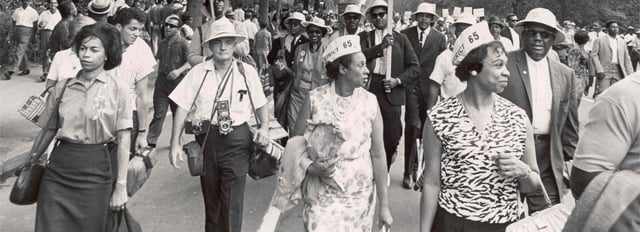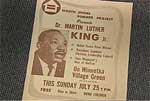
Civil Rights on the Northshore: Bringing the Movement Home
John Callaway hosts Rich Samuels' report on a group of people who brought the civil rights movement to their own
backyard.Winnetka, Illinois has long been home to the wealthy. And, until 1963,
it was typically insular; few of its well-heeled citizens gave racial issues
a second thought. But, on the centennial of Lincoln's Emancipation Proclamation,
a group of prominent Winnetkans set out to change that. And they started
a movement that would change their lives, and the town of Winnetka, forever.
Thirty years ago, the population of Winnetka was nearly all white. Resident
Anita Darrow remembers, "When my daughter was very young, a group of black
children came out from school. And she said, 'Oh, mommy, I didn't know
there were black children.' And I was shocked. That made me realize we
should do something." One thing Darrow did was join a group of prominent
Winnetkans who, early in 1963, sponsored a full-page ad in the Winnetka
Talk calling for racial justice. The ad pointed out that though a century
had passed since the signing of the Emancipation Proclamation, blacks had
not reaped the full benefits of citizenship. The signers called on their
fellow North Shore residents to join them in a battle to wipe out racism.
Rabbi Arnold Wolf also put his name on the ad. "I think we were guilty
about the pretty much lily-white character of the North Shore," he admits. "We
were leaders in business and finance and religion, and we were living in
a segregated community. And that didn't seem right. So we proposed to do
something about it. And that ad was the first step towards that."
With the exception of a clearly defined area in Evanston and a small enclave
in Glencoe where blacks had lived since the late 19th century, the North
Shore was whites-only. In 1959, an attempt by a courageous developer to
crack de facto segregation in Deerfield by building an integrated housing
subdivision had been rejected by the suburb. The progressives of Winnetka
wanted to avoid the debacle of Deerfield. So early in 1964, they developed
programs that would educate their community for change. Students formed
a human rights club and began tutoring black students on Chicago's West
Side.
The racial diversity the North Shore activists of the '60s hoped for has
not been realized; today only six-tenths of one percent of Winnetka's residents
are African-American. But what's remarkable about their stories is how
many of them still believe in and act upon Dr. King's dream of non-violent
social change.
Telling the Story
By program producer Rich Samuels
 Between
1959 and 1965, residents of Chicago's North Shore experienced a remarkable
awakening to civil rights issues. It began in November 1959 with an unsuccessful
effort to integrate Deerfield. It culminated in July 1965 when Dr. Martin
Luther King, Jr. spoke before a crowd of 8,000 on Winnetka's Village Green.
Between
1959 and 1965, residents of Chicago's North Shore experienced a remarkable
awakening to civil rights issues. It began in November 1959 with an unsuccessful
effort to integrate Deerfield. It culminated in July 1965 when Dr. Martin
Luther King, Jr. spoke before a crowd of 8,000 on Winnetka's Village Green.
Along the way, North Shore residents answered Dr. King's call, demonstrating
and volunteering in the SouthÑand then bringing the struggle to their own
neighborhoods where they sought open housing in previously all-white communities.
What motivated residents of one of the nation's most affluent communities
to reach out to the disadvantaged? Why, after roughly four decades, has
their drive for racial diversity on the North Shore achieved such limited
results?
Those are the questions I raise in the documentary. But I don't answer
them -- because I want to renew the debate sparked years ago by the North
Shore activists.
I began this project last spring when I discovered a surviving fragment
of a documentary Channel 5 (then WNBQ) produced in the spring of 1964 chronicling
the efforts of Winnetkans to prepare themselves for the day when the first
blacks would move into the village. (The documentary was mandated by WNBQ
general manager Bob Lemon, a Winnetka resident and a social progressive.)
Particularly striking in the Channel 5 documentary was footage of an interracial
exchange between black students of the Raymond School on Chicago's South
Side and the Sacred Heart parish school on Winnetka's northern edge. In
April 1964, a busload of Raymond School sixth and seventh graders spent
a week living with Winnetka families and attending Sacred Heart School.
The 1964 documentary pronounced the exchange "an unqualified success".
But how do the participants in that experiment (obviously now middle-aged
adults) regard it nearly four decades later? I tracked down as many Raymond
and Sacred Heart students as I could. Without exception they told me that
week in 1964 was an experience that transformed their lives.
I also tracked down student volunteers in the "North Shore Summer Project
of 1965," an effort to apply the organizing techniques first used in the
South to the lily-white northern suburbs of Chicago. It's remarkable how
many of the students of 1965 went on to follow careers that, in a number
of different ways, promote racial justice.
An Album of Activists
This documentary, in essence, is a series of profiles of those who were
part of the North Shore movement.
Featured are:
Oscar
Johnson & Jim McNulty
Raymond School seventh grader Johnson lived with the family of Sacred Heart
student McNulty during the 1964 interracial exchange.
Lilian
Calhoun
She and her husband became the first blacks to purchase a home in Kenilworth
in 1964.
Linda
Davis
This 1962 New Trier graduate volunteered for the "Mississippi Summer Project
of 1964."
JoAnn
Ugolini
A participant in the Selma march of 1965, she married a black athlete,
and learned firsthand that racial prejudice in Chicago matched that of
the South.
June
Carter Perry
She participated in the North Shore Summer Project and worked for fair
housing standards.
About the Program Producer
In addition to "Civil Rights on the North Shore: Bringing the Movement
Home," Rich Samuels produced a Chicago Stories documentary about
labor leader James C. Petrillo.
Samuels is a correspondent for Chicago Tonight with Phil Ponce.
He came to Channel 11 after a 17-year tenure at WMAQ-TV/Channel 5, where
he served as an investigative and general assignment reporter.
In his two decades as a journalist, Samuels has accumulated 13 Mies,
six Peter Lissa awards, a Jacob Scher award, a National Headliner award,
plus several honors from the Associated Press and the United Press.
He manages to combine his interests in history, broadcasting, and the web
by maintaining a site about Broadcasting
in Chicago: 1921-1989.
There's lots to explore in this online museum of broadcast history.

Your $40 Gift Membership will include:
|
























































